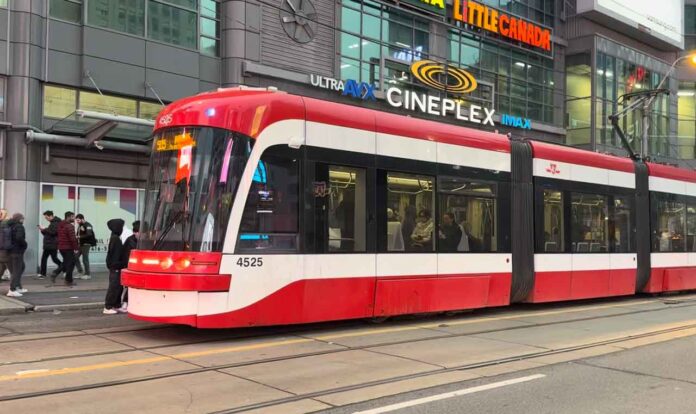Infra
Toronto’s Don River floods, and plans to prevent more chaos, offer urgent lessons for climate-challenged cities

On a stormy July day, the Don River flooded its banks. As nearly 100 millimetres of rain hit Toronto, the river surged from a trickle to a torrent. Currents spread across the Don Valley Parkway, one of Toronto’s major expressways, soaking sedans and turning a delivery van into an unlikely island.
The Don River, which flows south into Lake Ontario, has always been prone to flooding. Two centuries of settlement and construction worsened the situation; the river’s watershed, which once absorbed large quantities of rain, is now largely covered with asphalt and concrete.
That history has prompted a $1.35-billion project to remake the mouth of the river. The Port Lands Flood Protection project, when complete in 2025, will use hills and newly created wetlands to restore some of the Don Valley’s ability to soak up the rain.
This will protect a 240-hectare low-lying area of Toronto from floods – though not the area that was submerged in July.
The recent floods and the Port Lands project each have lessons for cities across Canada.
Many urban rivers and waterfronts are vulnerable to sudden floods. And as climate change progresses, extreme weather events such as the July storm are becoming more common and more destructive.
Experts say that the solutions will include infrastructure such as the Port Lands project, which will mitigate previous changes to the river system, lining the Don with water-absorbing greenspace and new overflow routes.
Equally important, however, are wider strategies to create what are known as “sponge cities,” controlling rainwater in every schoolyard, backyard and parking lot.
“You have to think in terms of the entire system. If you manage rain where it falls, that makes a big difference across an entire watershed,” says Nina-Marie Lister, an ecological designer and professor at Toronto Metropolitan University.
“It’s easy to look at an event like the July flooding and see that as a specific failure of one place and one city. But it’s actually everyone’s problem.”
Melissa Tait/The Globe and Mail; Christopher Katsarov/The Canadian Press
The July floods
As the river rounded an elbow bend, it had nowhere to go. At this point in the Don Valley, about three kilometres from the lake, the water slipped into a vise of compressed earth and pavement: railway tracks to the west and the Parkway to the east. At a low point near Gerrard Street, vehicles slowed to a stop as a wall of brown murk moved across the highway’s six lanes.
The storm had been so sudden that local police hadn’t even closed the road. Across Southern Ontario, it would wash out basements and pathways, causing approximately $940-million in damage, according to an estimate by the Insurance Bureau of Canada.
Toronto’s stormwater tunnels and treatment plants were already working hard after several days of heavy rain; six days earlier, a storm, the remnants of Hurricane Beryl, had set a city record for rainfall.
Rain flowed down the kilometre-wide slopes of the Don Valley and into the narrow river. In the lower Don, the Parkway and another road – Bayview Avenue – each run within 50 metres of the river. With nowhere to go, water gushed across their pavements.
This area is deep in the river’s flood plain. Similar inundation occurred here in 2013 and is likely to occur again, according to David Kellershohn, associate director of engineering services with the Toronto and Region Conservation Authority. “In any given year, our modelling shows there is a 20-per-cent chance that river flows will begin to spill onto the Don Valley Parkway at its lowest point,” he said.
Keeping these areas permanently dry, an enormous task, would mean reducing the amount of water that flows into them. To that end, Toronto is expanding its storm sewers. A $3.7-billion network of tunnels and reservoirs, now being built, will retain large quantities of stormwater in underground tanks and divert it to be treated and cleaned. But that work is far from complete; even when finished, it may not be adequate for a storm like the one on July 16.
History of the Don
“Never before in the history of Toronto has the Don presented such an appearance as it did yesterday, and at no previous time have its waters occasioned so much damage,” The Globe reported in September, 1878. In the previous week, the river had wrecked more than 20 bridges and 30 mills, killing two people.
The Don was already known to be changeable. “It’s a small river in the grand scheme of things,” says Jennifer Bonnell, an associate professor of history at York University. “But this seemingly placid small river misbehaved terribly at certain times of the year.” There were 13 floods between 1801 and 1881.
In the 1880s, the city reshaped the river’s lower stretches. The Don Improvement Project squeezed the river’s natural meanders into a straight, hard-sided channel. Such efforts reflected a “very vague understanding of how the river actually functioned,” Dr. Bonnell says. It successfully took over valley land for industrial uses and a rail corridor. The Don, like other urban rivers in the late 19th century, became a hub for noxious industries such as tanneries.
Yet flooding and pollution only grew worse. The green space along the river had regularly absorbed water during storm events; now this zone was drained or paved over. Silt, and an increasingly foul murk of industrial and human waste collected in the Ashbridge’s Bay Marsh at the river mouth.
And the Don’s curves had helped moderate the water’s force during storms; now they were gone. A “diversion” in 1909 sent the Don into a hard-right turn through the 36-metre-wide Keating Channel. This created “a huge flood danger,” said Dr. Bonnell. “They had straitjacketed the river but not really taken into account the effects of really large storm events.”
The last step was rebuilding the marsh, a rich ecosystem that covered more than 500 hectares at the river mouth. By 1921, landfilling began in earnest, creating what would be known as the Port Lands. The river ran out of room.
Jack Mitchell and Boris Spremo/The Globe and Mail
Port Lands flood protection
In 2024, huge efforts are being made to give it space again. “We don’t know when the next big storm will come,” said David Kusturin, chief project officer for the agency Waterfront Toronto.
Mr. Kusturin was trekking through newly planted grasses in a wetland near the river’s mouth, part of the Port Lands Flood Protection project that his agency has led. When complete in early 2025, it will protect against a worst-case flood far larger than the one in July.
“It could happen tomorrow, or 250 years from now,” he said. “We’re building to be ready.”
The PLFP will remake part of the Don and, just as importantly, the surrounding area. “We’re doing a combination of things that go beyond the river,” explains Emily Mueller de Celis, a partner at landscape architecture firm Michael Van Valkenburgh Associates (MVVA). “We are providing more places for the water to go; providing more capacity in the land along the river to absorb water in the case of a large flood; and then also directing the floodwater away from certain areas so that those don’t get flooded.”
MVVA, the lead designers of the project, are finishing up seven years of construction led by Waterfront Toronto and constructors Ellis-Don.
Carlos Osorio/The Globe and Mail
Today, the Don River runs south toward Lake Ontario and then veers sharply west into the concrete-lined Keating Channel. (“A river really does not like to make a sharp turn,” Ms. Mueller de Celis says wryly.) Soon the water will have two new routes into the lake: an overflow “spillway” to the south, and a long southwesterly meander, surrounded by 25 hectares of wetlands and greenspace.
On a recent tour with Mr. Kusturin, the new Don River still had gaps. A concrete dam dubbed the “north plug” kept the Don from running south into the valley. In the valley, lake water had washed into the new river channel; along its edges, new wetlands, part of what will become city parks, were bustling with waterbirds and butterflies. Clusters of porcupine sedge, switchgrass and brown-eyed Susans moved in the breeze.
While this looked natural, it was entirely constructed. To make the valley, crews moved 1.4 million cubic metres of soil, using much of it to make new hills. They engineered the riverbed with layers of stone, coconut mesh, carefully mixed soils and a layer of imported pine logs to prevent erosion and provide habitat for fish. Already, bowfin have been spotted in the newly dug river for the first time in living memory.
And Mr. Kusturin showed off another new piece of wildlife: a 10-metre-tall snowy owl. This, an enclosed climbing structure, anchors a new playground. Nearby, visitors will be able to borrow a kayak or canoe and enter the water in one of its new wetlands, engaging with the river in a way that a century of human intervention has made impossible.
“When you come and visit this park, you won’t even know that all of this work was done,” Mr. Kusturin said. This human intervention in the river, unlike those of previous eras, is designed to disappear.
Carlos Osorio/The Globe and Mail
What can be done
The key insight of the Port Lands project – the need to observe and respect the logic of natural systems – could apply in many places. Any waterway is part of a much larger system; the Don River, according to TRCA figures, draws from a watershed of 360 square kilometres, a zone that covers much of northeastern Toronto and extends into three adjacent municipalities.
“That watershed is one of the most urbanized in Canada,” explains Dr. Bonnell. Development “has introduced many hard surfaces,” she added. “Water moves fast through the watershed, picking up heat and pollutants.” This places an extra load on both the river and on human-made stormwater infrastructure.
Is there a way to keep the Don Valley Parkway from flooding under any circumstances? Prof. Lister said this is unlikely. But any effort to do so would require a regionwide change to the way in which stormwater is treated
The key strategy is to capture stormwater on site with areas of green space that retain water, and often help to treat it, rather than draining it into sewers. Chinese landscape architect Kongjian Yu coined a term for this: “sponge city.” Mr. Yu’s work involves large-scale parks and regional plans to apply this strategy at a metropolitan scale.
In Toronto, city hall has repeatedly studied a tax on hard surfaces, such as parking lots; such a tax would encourage landowners to install permeable pavements and replace some areas with planting beds. However, then-mayor John Tory shot down such a tax in 2017; earlier this year, current Mayor Olivia Chow backed away from it after a political uproar.
Such ecological water management is a powerful tool. “We understand what to do,” says Prof. Lister. “Green roofs on new buildings manage rain where it falls; when you are paving, make sure you put in soft surfaces. These things absolutely can make a difference.”
Many decisions like this will fall to individuals, especially people who own their houses. Residential land is a large majority of any city; homeowners choose en masse to create water-absorbent gardens, and redirect downspouts away from streets and into gardens. “Individuals, in that way, can make a meaningful difference,” Prof. Lister said.
Climate change, cities and you: More from The Globe
The Decibel podcast
Intensifying floods, storms and fires have been driving up disaster insurance claims across Canada, leaving homeowners with higher premiums and more limited coverage. Business reporter Clare O’Hara spoke with The Decibel about how insurers share the risk and cost of extreme weather. Subscribe for more episodes.
The art of climate resilience
Floods, fires, hail: Making Canada’s buildings climate-resilient
Lytton’s slow and steady rise from the ashes of 2021’s wildfires
Mark Carney: We all deserve affordable homes and a stable climate – and that is achievable









